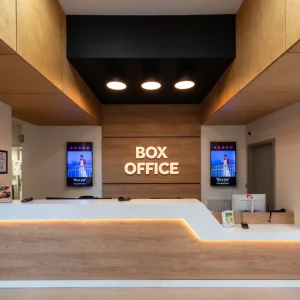Last month I wrote an article about the new attention being given to Jacques Tati in Paris, and the filmmaker’s complex relationship with architecture. Tati’s dedication to depicting this subject meant that the production of his classic, Playtime, involved a prolonged and troubled construction process.
The full story of the film began when Tati was visiting the United States and touring the European capitals for the promotion of Mon Oncle, between 1958 and 1960. Not surprisingly, he became familiar with international airports, which inspired many thoughts and observations that he immediately consigned to his notebooks. The script was finished in 1963, but this was only the beginning of what was to become one of the greatest and most unlucky creations in cinema history.
The filming, on location, started in October 1964 but was almost immediately suspended. Jacques Tati explained: “ It was not possible to stop the traffic at Orly airport, nor interfering with drugstores or supermarkets activities. Therefore, we had to create the whole set from scratch. So, I invented it. It took a very long time to build and was extremely expensive too.” And because Tati was very particular about the choice and use of colour in his films, having strict rules about monochromes and nothing else, Playtime was to be almost entirely shot in a studio. As a result, Tativille was born.
Conceived by Tati and drawn by Eugène Roman, Tativille gradually emerged in September 1964, from a 15,000 sq m wasteland in Joinville-Le-Pont, near the Bois de Vincennes. Soon afterwards, one could witness running escalators, residential and office buildings – with their steel and glass facades mounted on rails – asphalted roads, car parks and high-tech terminals. About 100 builders worked on the site for five months. Each building had central heating and two electric power stations were created to provide a reliable, artificial sun.
The first disaster came in the shape of a massive storm destroying the crew’s equipment. In the summer of 1965, the filming had to be postponed again because of bad weather, and financial problems had reached such a peak that, at times, the staff couldn’t be paid. Tati found himself forced to mortgage his own house as well as his rights on Les Vacances de Monsieur Hulot and Mon Oncle. Georges Pompidou, prime Minister and art lover, obtained an exceptional bank loan to help Tati who, by then, was totally buried in debts. In order to find new investors, Tati was even obliged to edit and show a part of the reel before the completion of the film.
But all this endeavour was in vain. The film premiere took place in December 1967 and, with only 400 000 viewers recorded at the box office, it lead to the bankruptcy of Specta Films and the sale of all Tati’s films rights.







